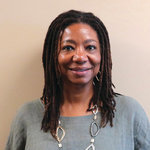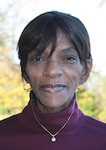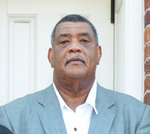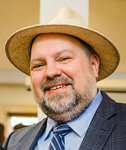



Editor’s note: As Black History Month winds down, we talk — in a two-part series, concluding next week — with several local leaders about the state of racism and race relations in Chatham County, looking at where we’ve been, where we are now and where we could be headed.
More than 60 years later, the memory is vivid and potent.
It was 1956. Summertime.
Del Turner was 6 years old — a kid from New York City visiting her grandparents in Wake County, as she did every summer during her youth — and at the moment the long ago memory begins, she was thirsty.
In a department store — Woolworths, or something like it, she remembers — on an outing with her granddad to buy lawnmower parts for a repair, the thirsty kid approached the fountain.
“I go to get a drink of water,” Turner said, “and before I could bend my head, I was on the floor. My grandfather shoved me away from the fountain.”
She didn’t understand, and her grandfather, feeling his granddaughter too young to know, didn’t explain.
“I, of course, I’m a kid,” Turner said. “I start to cry and he takes me out of the store immediately and we get in the truck. And he broke down and cried.”
At 6, Turner could read.
“But I did not see the sign that said ‘For Whites Only,’” she said.
“I did not understand until I was 10 what had happened,” she said, “because he felt like I was too young. But at 10 I turned on the TV in New York and saw little girls that looked like me being attacked by dogs. That’s when I knew this was the way it’s going to be. It wasn’t a good feeling.”
Like “most young girls” at the time, Turner had been fascinated by Barbie dolls, and Marilyn Monroe “was like my idol,” she said.
But “all that changed,” she said, with her awareness that the God-given complexion of her skin somehow set her apart.
As Turner matured, white-complected Barbie and all-American icon Marilyn Monroe were supplanted by other heroes: black political activist Angela Davis; the Black Panther Party, which had organized in the mid-Sixties to combat police brutality in Oakland, California, before expanding its scope and opening chapters in cities across the United States; and human rights activist Malcolm X, whom Turner’s father took her, when she was 11 or 12, to hear speaking to crowds in a bowling alley along Harlem’s thoroughfare Lenox Avenue, which poet Langston Hughes described as “Harlem’s heartbeat.”
Today, as Turner reflects on race, racism and race relations at age 70, her memory of that water fountain incident from her childhood remains the most dramatic experience that this lifelong civic activist has had with racism.
It was a long time ago, and some things are different today. But race, says Turner — who’s a member of the Chatham County Board of Education — still matters.
One could say progress has been made — the “whites only” water fountains are gone, Jim Crow laws erased — but it’s more like the paradigm has shifted.
“All that got translated into institutional racism, which exists today,” Turner said.
She points to racial disparities in the criminal justice system (“While there is a higher black rate of involvement in certain crimes,” reads a portion of a report to the United Nations on Racial Disparities in the U.S. Criminal Justice System by the Sentencing Project in 2018, “white Americans overestimate the proportion of crime committed by blacks and Latinos, overlook the fact that communities of color are disproportionately victims of crime, and discount the prevalence of bias in the criminal justice system.”) and what she said are “last hired, first fired” employment practices that target people of color.
She cites another example specific to Chatham County: a county policy for hiring minority contractors, which states 17 percent of work goes to minority businesses. “That means that 83 percent ...,” Turner said, leaving the sentence unfinished. “OK? People set these things up,” she said, “and I know that they don’t do it intentionally. But some do.”
A man-made construction
The little girl whose grandfather had abruptly pushed her away from committing a cultural sin at a fountain in 1955 grew up and continued her education in public and private schools in both New York and in Chatham County, where Turner’s mother was from and where Turner still had family roots.
She attended the segregated Goldston Colored School (now J.S. Waters School) and the Laurinburg Institute in Scotland County, where she recalls seeing white sheet-clad members of the Ku Klux Klan once fanning out onto a football field in a display of dominance.
Turner serves still, as she has for several terms, as an elected member of the Chatham County Board of Education. Her civic involvement also includes stints on the Chatham County Planning Board, the Affordable Housing Task Force and the Chatham County Health Assessment Team.
She balks a bit at the term “racism.”
“For me, racism doesn’t exist, because it’s a man-made construction,” Turner said. “It’s not something that’s a natural creation or evolvement. So when I think about racism, the only thing that matters to me is a lack of access for some groups as opposed to others.
“Most people in my community,” she said, “feel like when we’re fully integrated, everything will be OK. I’m like, ‘How? That’s just another myth you’ve bought into.’ Because what good does it do me if you and I can go and sit down in Red Lobster together, sit in the movie house together, and laugh and talk together? How does that put steak on my great-grandson’s plate, as opposed to oatmeal? For me, it’s always been about a lack of access.”
Carl Thompson — who served two stints on the Chatham County Board of Commissioners, first when he was fresh out of college from 1978 to 1990, and again from 2006 to 2010, and remains one of only several African-Americans elected to the county’s governing board — said race is a “social construct” which has evolved over hundreds of years, though always to the disadvantage of blacks.
“At one time,” Thompson said, “Italians weren’t considered white. Irish weren’t considered white. Hispanics weren’t considered white; some of them still aren’t. The definition of ‘white’ has changed.”
But a lot depended on that social construct and where a person — and the color of their skin — fell within it.
After World War II, for instance, the United States began subsidizing loans for war veterans through the G.I. Bill, said Thompson, a history major in college and a self-described “history buff” today.
Those loans were available to many ethnicities, all considered white, but not available to blacks, Thompson said.
“We were systematically denied those loans by the government,” he said. “It’s history.”
So while white war veterans, with the assistance of government loans for housing, fanned out in post-war America to populate growing suburban neighborhoods, “there were apartments built in the city for black people,” Thompson said. “So then you have these tenements and high-rises. Black people went and fought for their country and came back home and got nothing for it. Whether race is real or imagined, you can see the manifestations of racism. That’s undeniable.”
The same playing field
When Turner speaks of “lack of access,” she’s not talking only about water fountains.
“If I have the same access you have,” she said, “if I can afford to live in Governors Club, I can go any place that I want to go and not be stared at, then, for me, that is equity. That’s everybody playing on the same field. But once you exclude me from something simply because of this,” she said, touching her wrist and letting the sentence trail off.
“The goal post keeps getting moved all the time,” Turner said. “I have a right to be angry about that. All I want is access. I don’t have to like you. I don’t care if you like me. America has a contract with its citizens. As an African-American woman, I’m still enslaved because I don’t have access to everything the Constitution of this country promises me.”
Randy Voller, former Pittsboro mayor, grew up in Indiana, moving to Chatham County in the 1990s. A real estate developer and a man involved throughout his life with various social justice movements, Voller has observed race through both of those lenses.
“It’s metastasized,” Voller said. “It goes back to structural issues in our economy that were detrimental to people of color, specifically African-Americans. A lot of the great reforms of the 1930s didn’t fully extend to African-Americans. There are structural issues in the system that need to be addressed. At this point, the chasm is pretty wide.”
Of race relations, Voller said, much “depends on your perspective.”
“For certain folks — generally speaking, white folks — either they didn’t notice there was a problem, or it had always been the way it always was and it wasn’t a problem,” he said.
“It’s very balkanized up north,” Voller continued. “You have the 8 Mile in Detroit, all of these ethnic neighborhoods separated by race in Chicago. In the North, Barrack Hussein Obama could come from Chicago and he could dream to become president — and become president — but ‘you can’t live in our neighborhood.’ In the South, more specifically the Old South — but what I’m describing is essentially an American phenomenon, just depends on concentrations of race and ethnicity — but in the South, you could live next to each other, but ‘you better not dream to become president.’ Here, you’re interacting and seeing people. But then, seeing people doesn’t equate to social justice or people feeling fairness or equality in the system.”
An abrupt awakening
Karen Howard, the chairman of the Chatham County Board of Commissioners and former member of the county board of education, moved at age 5 from New York to the Bahamas.
“I did not grow up in the United States,” she said.
The demographic in the Bahamas was much different than in the U.S., with 90 percent of the population there black.
“I didn’t have an early understanding or experience of race as a social construct,” Howard said.
As a teenager in the early 1980s, she returned to the states to attend boarding school — a “contrived environment,” she said, in which she shared with her mostly white classmates and friends the same socio-economic status — but didn’t return to the U.S. to live full-time until she was 30, moving into a “very racially diverse” neighborhood in New Jersey and living there for a while until she moved with her husband and their children to North Carolina, where they settled in Chatham County.
“I came,” she said, “with a disbelief that racism in America still existed in the way that I had seen it in books and the way that I had learned Martin Luther King and that whole historical thing. And I believed that for a long time. I think the first time I recognized that I was being treated differently was when I moved here. I would say that having black sons was an awakening, an abrupt awakening. I had to learn that I was black in America, and that that meant something.”
For her sons, it meant being excluded from a program for academically gifted students.
“Two of my sons are extremely gifted in math,” she said, “which is a gift they didn’t get from me.”
The boys — then ages 8 and 10 — were enrolled at North Chatham Elementary School and both had scored very well on standardized math tests, testing well above their grade levels, Howard remembers.
But neither of her math-gifted children — both of whom later attended the N.C. School of Science and Math and one is today majoring in mathematics at the University of North Carolina — was enrolled in the school’s academically gifted program.
“I hadn’t even been told there was one,” she said. “When I looked at the gifted math program, it was all white kids, all white boys. And I challenged it. I just couldn’t make sense of it.”
Howard joined an Academic AIG Task Force, she said, “looking at whether we were, as a district in Chatham, being equitable in attributing giftedness to all demographics. The information raised up showed we were not. We were not identifying giftedness in minority children, generally, well. So we took steps as a district to address that. And that was when it landed with me, that there were probably multiple occasions where race played a role, but because it was not overt, it wasn’t practiced in a hateful way, which is what I think we anticipate when we talk about racism, I didn’t recognize it.”
That recognition was coupled with disbelief.
“It’s difficult to accept something that contradicts everything you think you know,” she said. “My experiences of America had always been one of feeling included, valued, respected. So when things happened, it was very hard for me to put them in context. In retrospect, I realized, well, things had happened in boarding school that I didn’t translate or interpret as having anything to do with race.”
There had been an incident — tucked away in memory and mostly unprocessed — when Howard was younger, attending the boarding school in New York, on an outing with her girlfriends (she was the only African-American in the group, though that didn’t stand out to her, race not being a novelty among the boarding school set) when she was refused service.
“I eventually got served, last,” Howard said. “I didn’t have any way of interpreting it at the time. At the time, I just wondered ‘Why is the person behind the counter ignoring me?’ It was probably my first experience.”
Hurtling into the future
The United States is now, as Bob Pearson puts it, “hurtling into a future of growing opportunity and challenge” where race relations are concerned.
Pearson, who retired to Chatham County in 2015 following a long career in the American Foreign Service, is a member of Chatham Community NAACP Branch #5377 and has spearheaded ongoing efforts to memorialize Chatham County’s six lynching victims.
“Central North Carolina, including Chatham County, is one of the two fastest growing mid-size urban areas in the United States and is projected to increase in population by over 70 percent between 2010 and 2030,” Pearson said.
“Chatham County should be seen as a model for that growth,” he said, “as a harmonious and welcoming place to live and raise families and provide good jobs. These possibilities were obvious to my wife and me when we moved to Chatham as our adopted home five years ago to be closer to our family and grandchildren in Charlotte.”
Pearson says nearly everyone he meets shares the goal of “a better county for all our citizens, black, white and Hispanic.”
“This majority seems willing and ready to reach out to others in order to move past divisiveness,” he said. “They want race relations to improve in order to take advantage of these future opportunities.”
In part two of this story, to be published in next week’s News + Record, we’ll take a closer look at how some other local observers regard that future and what they believe it will take to make Chatham County more “harmonious and welcoming,” and at some of the hurdles — including ongoing conflicts in Chatham County over the removal late last year of the confederate monument in Pittsboro — that persist.
Randall Rigsbee can be reached at rigsbee@chathamnr.com.

Howard
Howard

Turner
Turner

Thompson
Thompson

Voller
Voller